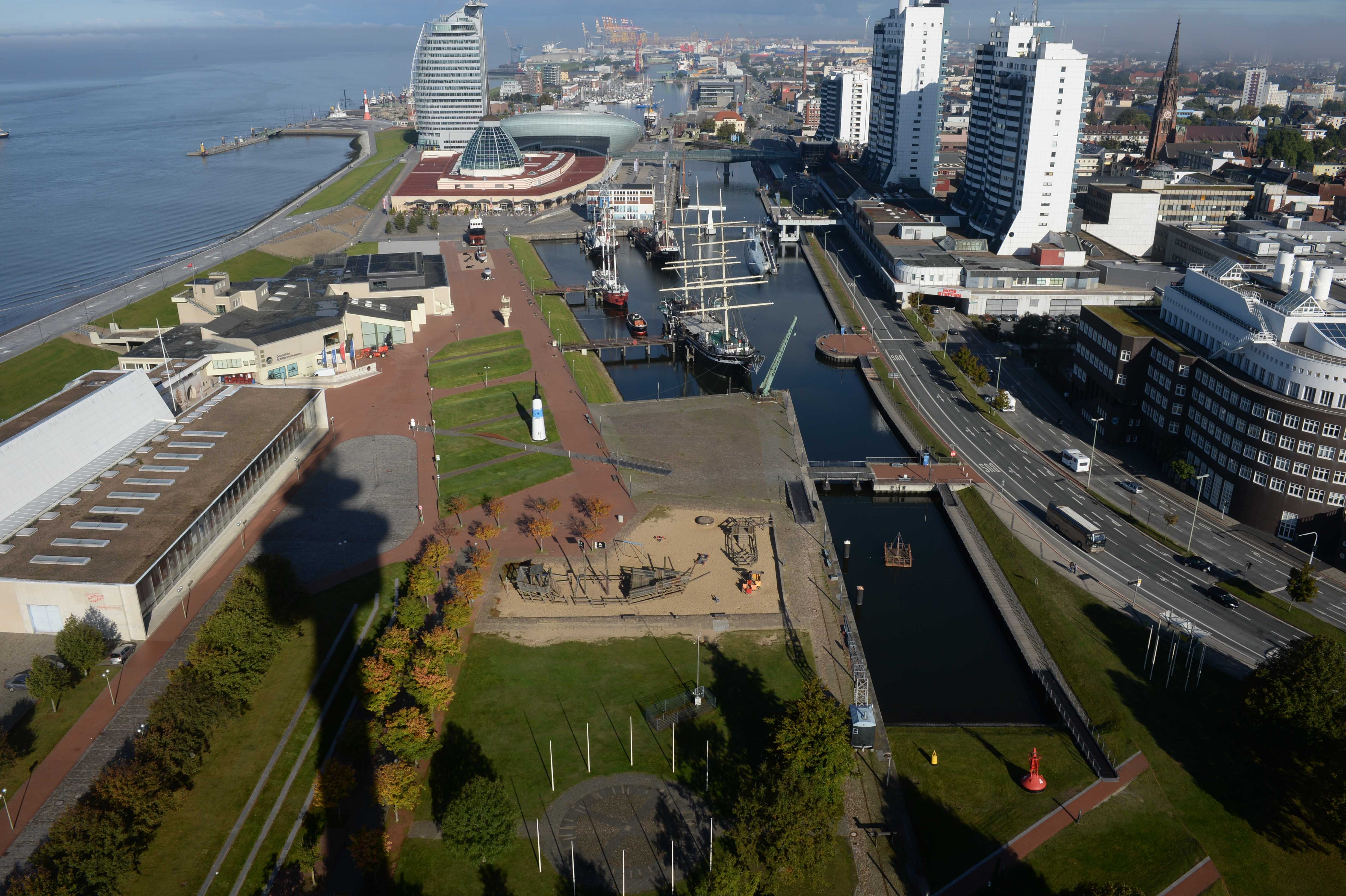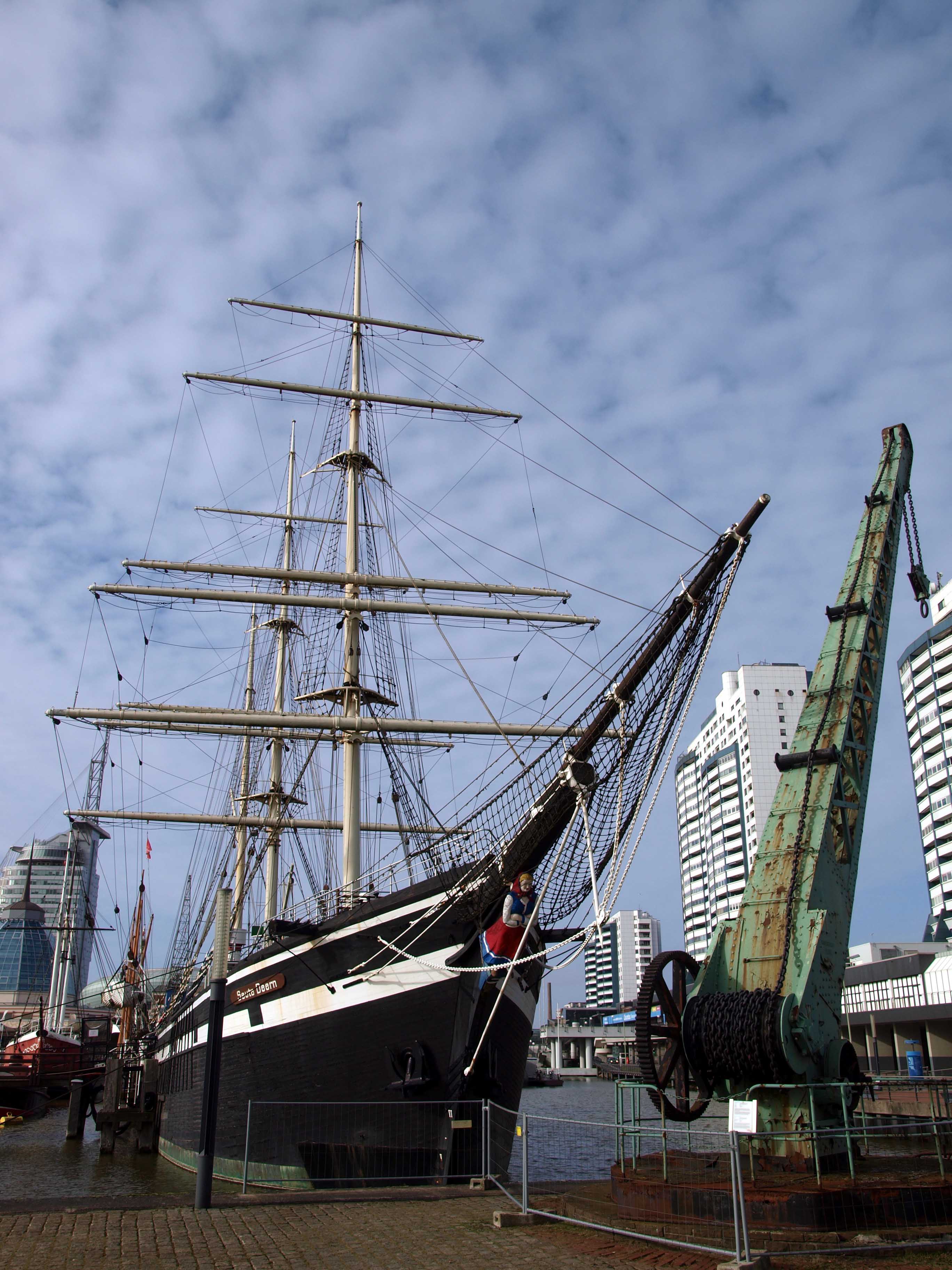Harbors like all other human constructions are subject of constant renovation. The pressure laid on them is remarkable high as it is for the most infrastructural building. Especially in times of ongoing globalization harbors have a key role, therefore the economic competition is massive, as well as the need to provide the best possible conditions. Ship sizes, trans-shipment techniques, organizational processes and hinterland connections developed rapidly in the last years and will continue doing so in the future. Loading and unloading facilities in bigger harbors, being state-of-the-art thirty years ago, are no longer efficient and facing deconstruction. A fact that does not affect other structures in the same way. Residential buildings, religious gathering places or office houses are limited in their extent and forming only in combination with other constructions a historical quarter. At the same time, a harbor with all its features is a large-scale complex, influencing other urban quarters in its surrounding area. Furthermore, the multiple parts of a harbor are influencing each other directly, meaning that changes in a small scale can have a significant impact on the whole system.
For a long time, the constant renewal of industrial areas including the demolishing of older structures was general accepted, even welcomed, but in the 1970th, a paradigm change took place. Not only art works or places with a high individual history, like a birthplace of an important person, have been recognized as deserving protection. Since the early 20th century, also commonplace buildings like farmhouses are secured. The will to save certain industrial monuments in Germany spread out mostly from mining regions in the west of the country and has been adapted by other regions and fields. Between 1983 and 1988, a research project on maritime industrial culture was carried out under the aegis of Dirk Peters at the German Maritime Museum. The attempt was to inventory historical as well as modern shipping facilities along the German North Sea coast [1]. Comparing the 1980th stock with the current situation, it is visible that we are still facing an enormous loss rate. While fires, natural catastrophes or criminal destructions are assumed to be the biggest threads, the non-usage is even more dangerous for industrial monuments [2]. The absence or inefficiency of utilization concepts for 20th century structures is caused by three main reasons. First, a stable outdated for agricultural needs can be transferred into a living quarter or an event location. It is difficult to use a harbor crane in another way than lifting goods. Only few laborious examples for tiny hotel rooms exist. Second, most of the historical constructions like docks are still located in active harbor zones. These are non-public areas making the usage impossible. Third, dealing with maritime monuments and landmarks is a niche inside the field of heritage management. Experiences on longtime and sustainable usage of complex technical installations are quite rare. Therefore, many objects linked to the former harbor disappear sooner or later, sometimes after a longer period of ruinous existence before being disposed.
The Alte Hafen of Bremerhaven – Museum area of the German Maritime Museum
Despite that harbor basins, gates of locks, railway tracks or docks cannot be transferred, several historical maritime objects are moved an gathered in certain areas, as it can be seen in Bremerhaven. Since the establishment of the German Maritime Museum 1975, a collection of different historical objects exists at the Alte Hafen (old Harbor). Especially during its founding period, the assembly was expanded and is one of the major points of attraction ever since.
The foundation of Bremerhaven in the north west of Germany is linked in a vital way to the Alte Hafen. Sanding up processes of the river Weser forced the town of Bremen to relocate the town harbor, existing since the Middle Ages, closer to the shore. This took place in 1830 with the completion of the first harbor in Bremerhaven. The town grew constantly around this area and has today 113.000 inhabitants. Bremerhaven is now the only large German city at the North Sea. With the developing of the town, further extensive harbor basins have been built and a 5 km long quayside along the river was constructed. Currently Bremerhaven is the fourth biggest container harbor in Europe after Rotterdam, Antwerp and Hamburg.
Originally the harbor had a length of 750 m, was 57,5 m wide and 5,25 m deep. The access was possible by a lock, allowing loading and unloading independent from the tide. The lock was filled with soil already in 1926. Since then the Alte Hafen is accessible via the Neue Hafen (new harbor) from the North by a canal. With the massive spreading of harbor areas and the changing requirements by the users, the harbor lost its function. Bigger parts have been filled up in 1974 and a smaller part was extended to give room to the museums harbor. Today the whole basin is mostly used for inactive museum vessels. The original structure is almost lost. Merely a small section of the former brick-built quay and a short railway track remained at their original location. A former toll collection house built in 1897 and used since the 1970th as a restaurant as well as a granary, used in the last years for different purposes, are the last remains of the original harbor development. The extensive collection of cranes, navigation objects, ships and other items have been transferred here mostly in the 70th and being presented at this place ever since (see image below) [3].
Overview of the Alten Hafen and and the German Maritime Museum in the foreground and the North Sea in the background. (Wolfhard Scheer 2013, © Deutsches Schifffahrtsmuseum).
The new Alte Hafen – Between nautical romanticism and modern Port Center
Following the current fashion, the concept of the museums harbor in the 70th was understood and carried out as an open-air museum. Visitors should explore and experience to navigate on the sea. The needed knowledge and imagination presuppose the visitors should relieve shipping, living on board and work life in a harbor [4]. This original concept has not been changed ever since. Visitors can examine cranes from outside or step onboard and inside a whaling ship or a heavy tugboat. Until recently Europe’s last large wooden sailing vessel the SEUTE DEERN was an exception, being used as a restaurant since the 1950th (see image below). Here, high quality dishes in a maritime atmosphere have been served, admired by locals as well as by tourists [5]. Exceptional at its founding, the museums presentation lost its unique selling point today. Other harbor towns established their own museum harbors or at least interconnected single traditional vessels to their touristic presentation. Not only for Germany, but other countries as well, Bremerhaven was role model and best-practice example. The possibility the visit old ship is essential to modern tourism strategies at the coast, even if they “only” function as a maritime scenery. The same must be said for infrastructural constructions like cranes and quays.
The last large wooden civil sailing vessel in Europe SEUTE DEERN, built 1919. (Lars Kröger 2018, © Deutsches Schifffahrtsmuseum).
While the visitor had still a personal link to harbors and ships in the 1970th, society is now disconnected to most of the processes in bigger harbors. The view from the other side of the fence, the window of a bus or a harbor tour by boat is the closest a visitor can get today to the daily harbor routine. Simultaneously, the employment rates in harbor economics are descending while procedures getting more and more complex. Museums are forced to fill this gap and act as mediators. Before self-experiencing the work on the bridge of a tugboat, an understanding of why and how this kind of vessel is used is required.
Since several years, the German Maritime Museum is in an ongoing renovation process. 8.000 m² of exhibitions area get a new conceptual design. New thematic focuses have been developed to full fill the requirements of a modern research based museum; a German specialty were research and exhibition work are directly linked. General plans to redevelop the outside area of the museum, have been carried out since some years. Starting with this year, those ideas will be specified and brought to action. The attempt is to give the visitors an understanding to the harbor as the contact zone between humans on land and occurrences on the sea. The genesis, current situation and future developments of harbors in general will be stressed out and be interconnected with their logistic systems. In the last years, Bremerhaven evolved more and more to a science location. Research institutes with a focus in marine and maritime topics gathered here [6]. These institutes are complemented by several public agencies and of course, the big sector of maritime industries located in Bremerhaven. Following the example of other harbor towns a Port Center is in planning. Here the cosmos Harbor will presented to the visitors. It is the attempt to use the local knowledge and put it on display in a modern way, in accordance with scientific standards and the requirements of a modern research driven museum. Harbors and ships have a direct impact on everyone life, but being concealed to the most. The significance of shipping in people’s existence should not only be revealed to those living in coastal areas.
At the same time, the whole area of the Alter Hafen has to be revitalize. With the formation of the German Maritime Museum in the nucleus of the town, the core of the modern scientific location of Bremerhaven, has been established. Since then the complete usage of buildings and open space changed drastically. Museum advancements and the development of new attractive offers have to come hand-in-hand. This is a special challenge for future planning. In 2005, the ensemble of prize winning museums architecture and all museums vessels in the Alte Hafen have been giving protection by monument conservation laws. At the same time, the maintenance of the old ships is a financial challenge. Luckily, the Federal Republic of Germany, the state of Bremen and the town of Bremerhaven support the renovation and new presentation of the vessel SEUTE DEERN with the prospect of 34 million € over the next years. It is planned to do the makeover in front of the visitors and inhabitants of Bremerhaven in a transparent dockyard situation. This transparent dockyard will be the starting point for a new future of the old harbor in Bremerhaven.
Notes
[1] Peters, D. (1989), Maritime Industriekultur in den Norddeutschen Küstenländern. Eine Bilanz der Inventarisation und Dokumentation schiffahrtsbezogener Objekte an der deutschen Nordseeküste von 1983 bis 1988, in Deutsches Schiffahrtsarchiv, Bd. 12, pp. 319-342.
[2] Pedersoli Jr., J. L., Antomarchi, C. & Michalski, S. (2016), A Guide to Risk Management of Cultural Heritage, Ottawa.
[3] Kähler, K. (2013), Museumshafen und Museumsschiffe – das “Freilichtmuseum” des Deutschen Schiffahrtsmuseum, eine Bilanz (internal paper of the German Maritime Museum), Bremerhaven.
[4] Schnall, U. (1977), Schwimmende Oldtimer der Seefahrt. Führer des Deutschen Schiffahrtsmuseums Nr. 3, Bremerhaven.
[5] Just bevor finishing this article there was a fire on board in the area of the restaurants kitchen. The search of the reason and the extent of the damage is still going on. It is clear by now that no restaurant will reopen on the vessel before the extensive renovation process (situation around 27.02.2019).
[6] Next to the German Maritime Museum the most relevant institutes are the University of Bremerhaven with mutiple study programs in fields connected to usage of the seas, shipping and offshore industries, the Alfred Wegener institute, the world leading institute for polar and marine research, the Fraunhofer Institute for Wind Energy Systems, the Institute of Shipping Economics and Logistics, the Thünen Institute of Fisheries Ecology and the Institute for the Protection of Maritime Infrastructures.
References
Deutsches Schifffahrtsmuseum (https://www.dsm.museum/)
Head Image: Inside the museums harbor of the German Maritime Museum. (Lars Kröger 2018, © Deutsches Schifffahrtsmuseum).

